John Brown and the Midnight Cat is a classic Australian picture book written by Jenny Wagner and illustrated by Ron Brooks. This story is an excellent example of how a story for children can mean something completely different — and disturbing — for adults. This children’s story gives me chills.
As you read, pay special attention to the pictures in this one, which tell a very different story. Recall everything you’ve ever absorbed about universal symbols. Pay attention also to the way vertical lines and framing is used to separate character from each other, also separating inside from outside.
STORY STRUCTURE OF JOHN BROWN, ROSE AND THE MIDNIGHT CAT
PARATEXT
Rose’s dog feels he can look after her without any help from a cat, but Rose has different ideas.
Marketing copy
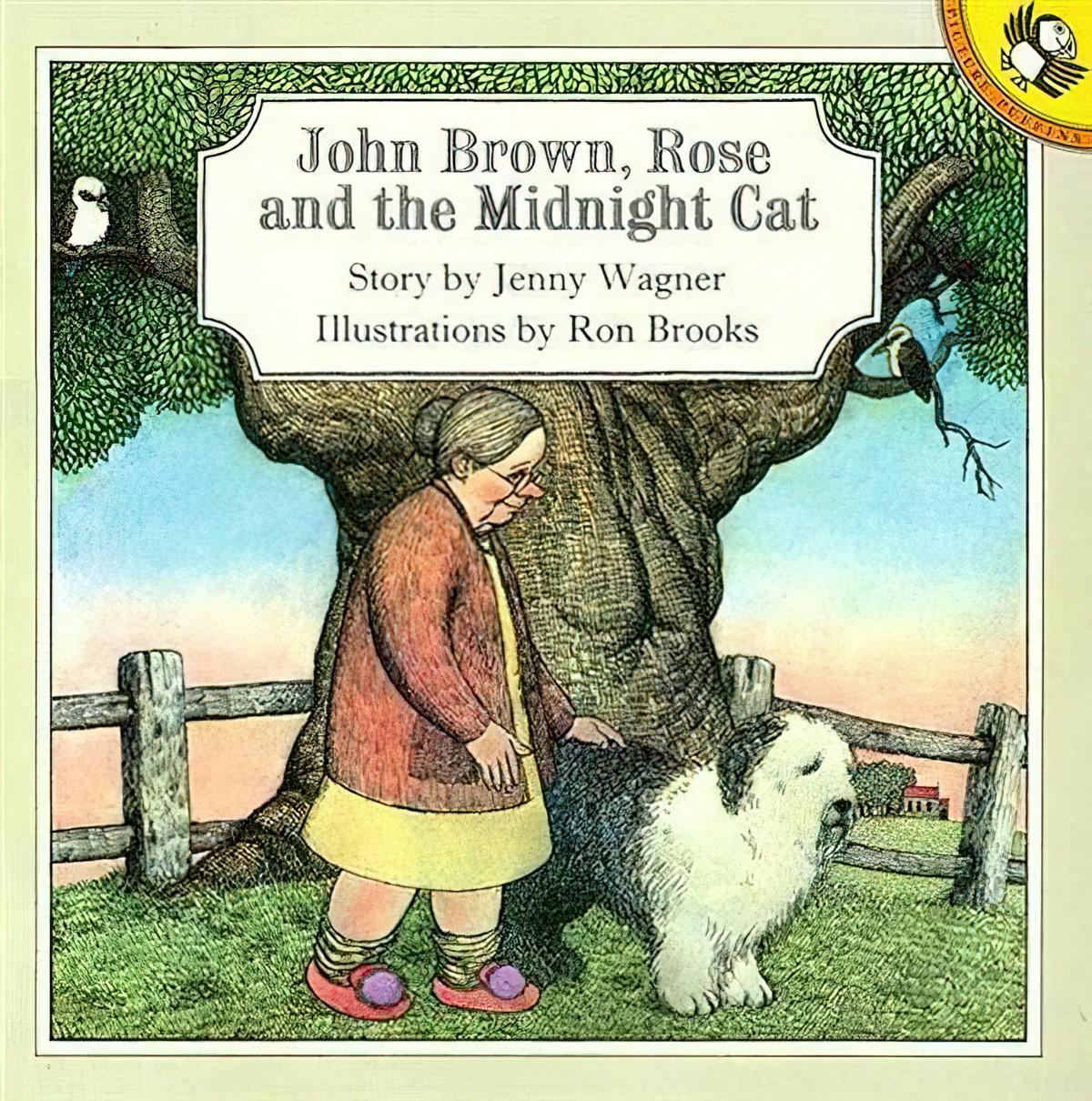
SHORTCOMING
The opening sentence opens with death. But in children’s books, death which happens off the page is not experienced as grief by the child reader. Keep that in mind as you read…
Rose’s husband died a long time ago. Now she lived with her dog. His name was John Brown.
The childlike character in this picture book is John Brown. You might expect this dog to have a name that describes him — I expected a brown dog. But no, he’s a big Old English sheep dog. It’s mildly comical that he has a generic human name and goes by both first name and ‘surname’.
The storytellers take some time to establish the very close relationship between woman and dog.
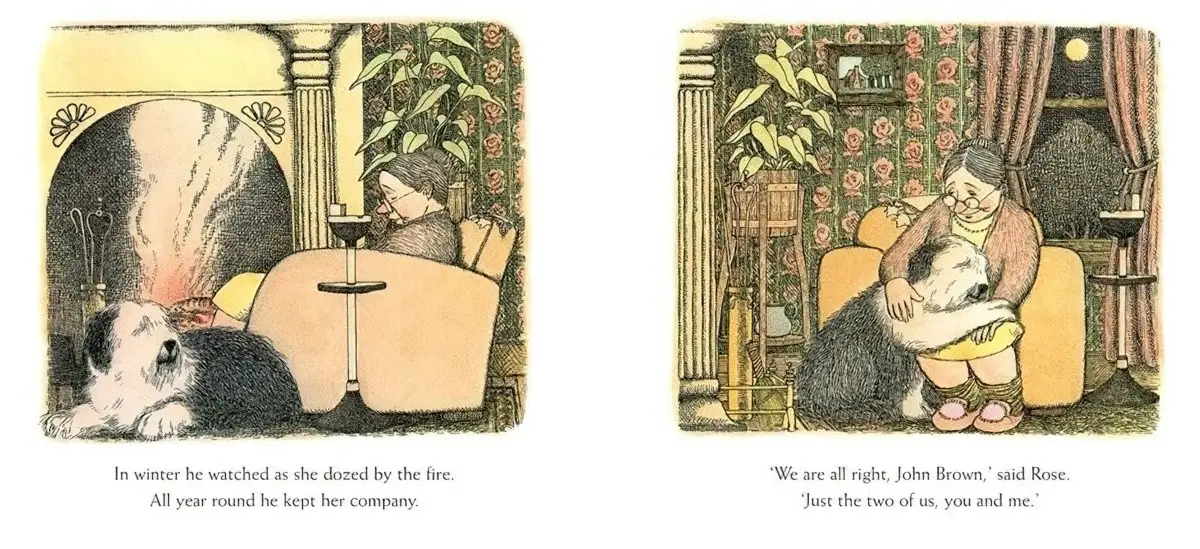
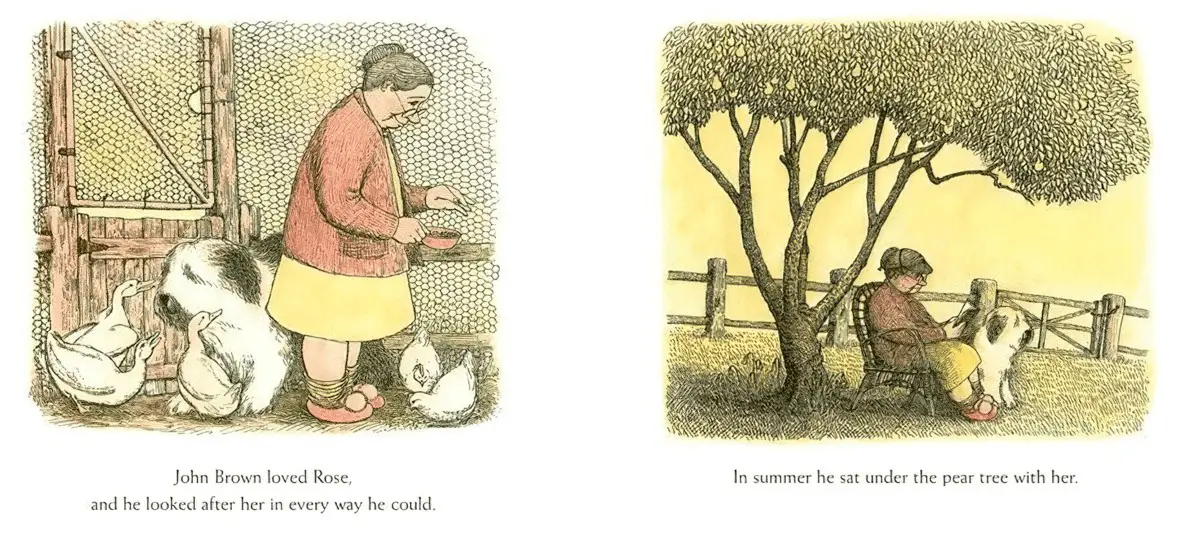
How ‘animal’ is John Brown, human name aside? Until the Anagnorisis part of the story John Brown does talk (ie. dialogue is attributed to him), but human Rose doesn’t respond directly , suggesting she can’t hear him, or isn’t listening. This technique is used in many animal stories, for instance in Courage The Cowardly Dog. In this way, John Brown is a toddler. Toddlers have thoughts and emotions but don’t yet have the language to express themselves properly, accounting for the multitude of daily frustrations.
DESIRE
John Brown wants to be by Rose’s side forever.
John Brown loved Rose and he looked after her in every way he could. In summer he sat under the pear tree with her. In winter he watched as she dozed by the fire. All year round he kept her company.
OPPONENT
This sentence foreshadows the arrival of someone new, someone unwelcome.
“We are all right, John Brown,” said Rose. “Just the two of us. You and me.”
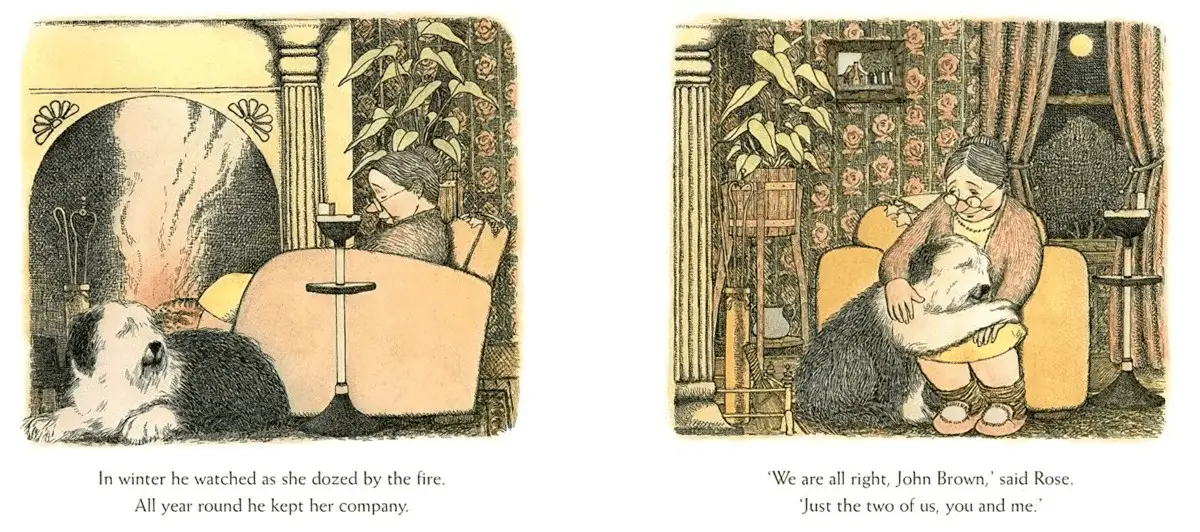
‘One night’ marks the shift from the iterative to the singulative, which coincides with the arrival of the opponent. At this point, suspense is heightened. What is the thing in the garden?
One night, Rose looked out of the window and saw something move in the garden.
This black cat has eyes that shine like lamps and along with the broom on the porch, and the moon, and the link between the cat and the sky, the story conveys an ominous supernatural vibe.
PLAN
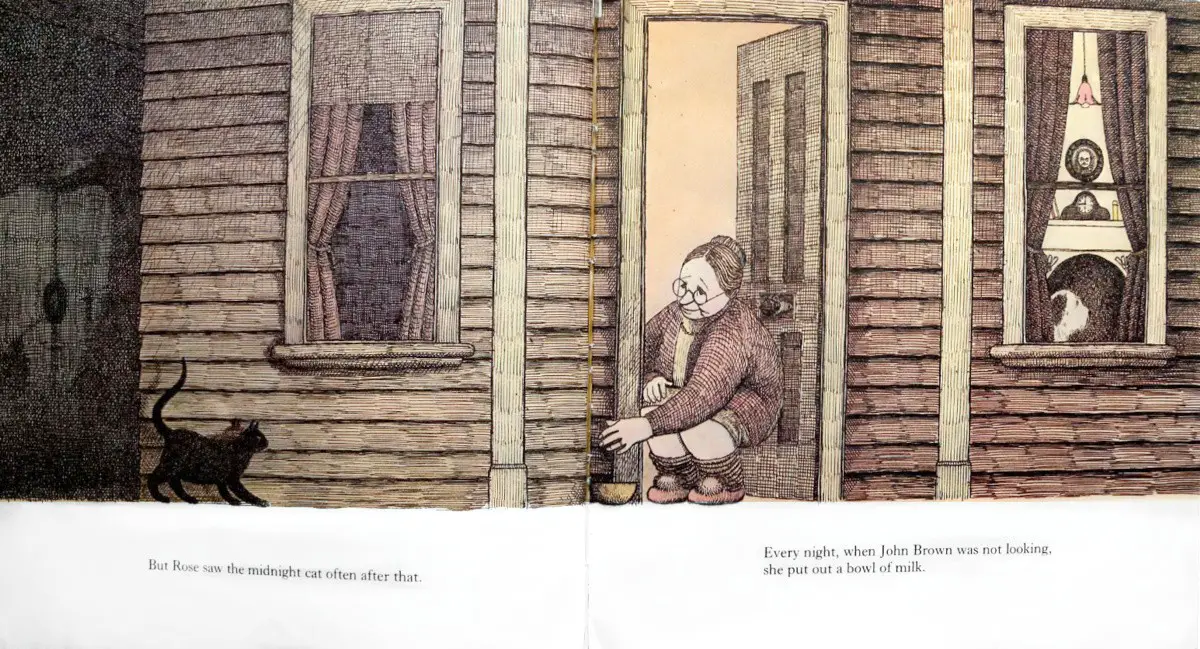
John Brown refuses to look out of the window. He wants his life to continue on just as it always did, with himself and Rose together, enjoying each other’s company.
Although John Brown appears to turn a blind eye to this intruder, at midnight he draws a line around the house, reminiscent of witches. He tells the cat to stay away.
“We don’t need you, cat. We are all right, Rose and I.”
John Brown, Rose and the Midnight Cat is basically a ‘New Baby’ book for children who must deal with a new baby into their household, or for children living in blended families. John Brown feels possessive about Rose in the same way a child feels possessive and anxious about losing the attention of parents.
I wonder if the pear tree is quietly symbolic. Pear trees are regularly a metaphor for maternity and fertility in storytelling.
Meanwhile, ‘Every night, when John Brown was not looking [Rose] put out a bowl of milk.’ Every night, when the older child is asleep, their mother gets up to feed the newborn sibling.
Rose and John Brown are each other’s opponents. The cat appears happenstance. ‘And every night when Rose was not looking, John Brown tipped it out again.’
“You don’t need a cat… You’ve got me.”
THE BIG STRUGGLE
John Brown reaches the climax of his psychological struggle by refusing to have anything to do with the new arrival:
“Isn’t he beautiful,” said Rose. “John Brown, let him in.”
“No,” said John Brown. “I won’t let him in.”
Rose talks about the cat as a mother talks about a new baby. ‘No, I will not let him into my affections. I didn’t ask for this baby.’
Rose becomes bedridden. The opening page told the readers her husband has already died, and we worry she might, too. She tells John Brown she’ll be staying in bed “All day and forever”. If we read the images, Rose has earlier been winding the clock, suggesting that her time is running out.
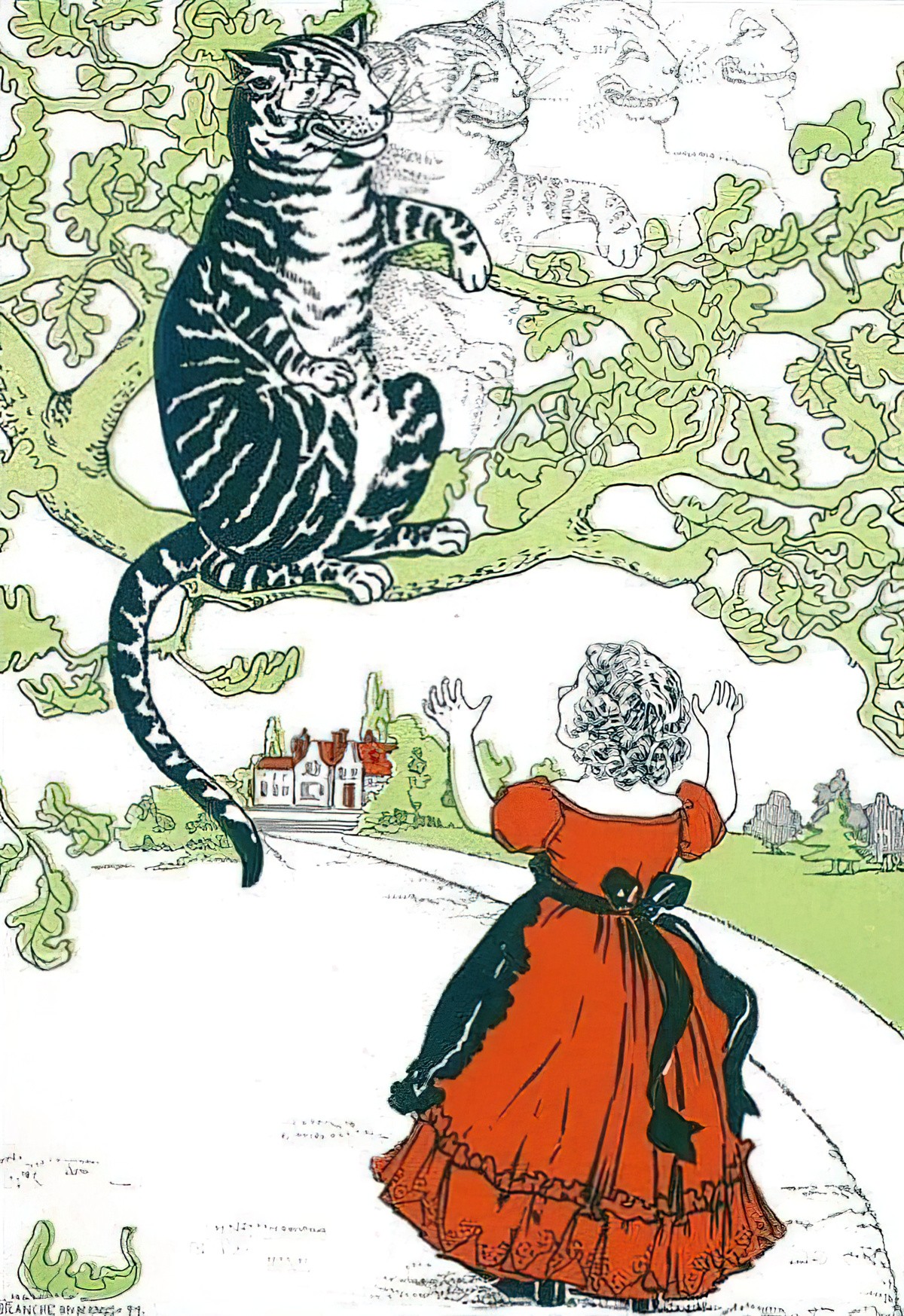
Another story about an old woman who goes to bed very ill at this part of the story is Miss Rumphius by Barbara Cooney.
Miss Rumphius doesn’t die.
This is where the story splits off into two separate interpretations:
- The old woman feels sad and a little sick, but John Brown is able to sufficiently cheer her up until she gets back up to feed him again and keep him company.
- The old woman dies in bed. The black cat comes in because the black cat is death. This is why John Brown is not getting fed.
The bedridden part of the story is the weakness of the literal level story, and some readers feel strongly about that. Considering young readers will pick up the literal level of a story, to say that a literal reading is ‘the wrong’ reading is wrong in itself, and I’m not saying that. Here is a response from a literal-level reader:
Poor John Brown is presented as a villain as he tries to keep the cat from encroaching further. Rose demonstrates no empathy for his position. Then she resorts to pure manipulation in order to trick John Brown into accepting the cat: She claims to be ill, takes to her bed, and refuses to get up and feed John Brown or let him out, until he asks, “Would you feel better if the cat came in?” Oh, yes, of course she would! She leaps out of bed, lets the cat in, and they all live happily ever after.
WTF?! […]
What kind of a relationship is modelled here? Not a healthy one, that’s for sure. If Rose is representing a mother, John Brown a child, and the Midnight Cat a new member of the family (baby, step-parent, whatever), I can guarantee you that John Brown is probably going to be suffering from depression and emotional confusion, and will end up messing up most of his own relationships down the road as a result of this kind of manipulative, invalidating, abusive (refusing to feed him? really?) “parenting” by Rose, and its discouragement/avoidance of any genuine, honest communication.
from a Goodreads consumer review
For some reason, Rose wants to bring the cat indoors. John Brown, who’s either jealous, OR protective, wants the cat to remain outside. The old lady plays sick until John Brown bows to her wishes.
from another Goodreads review
ANAGNORISIS
Symbolic readers will have their own realisation. The old woman is dead, the cat is the grim reaper. The black cat is death, and as the old lady welcomed the cat, she was preparing for her own death.
On a literal level, John Brown waits for his breakfast. ‘And nothing happened.’ Since the literal reading is the reading which relates to young children the reading is this: Whenever there’s a new baby in the house, older siblings have to wait a while for things like that. In this case, the revelation comes after some thinking.
John Brown thought. He thought all through lunch time… and when supper time came, he was still thinking.
Next, John Brown and Rose have a conversation in which John Brown asks a question and Rose responds directly. This is very subtly done, but this small change shows that Rose and John Brown are now on the same page. John Brown has realised that if he accepts the Midnight Cat, Rose will cheer up.
But if we are reading the story on a symbolic level, the reason Woman and Dog are now able to communicate might be ascribed to some spiritual belief system in which death confers some sort of psychic communion with animals, unavailable to us as living, thinking, higher-order humans.
NEW SITUATION
Literal reading: John Brown lets the cat in. All three of them (appear to) sit by the fire. The cat purrs.
Symbolic reading: John Brown’s owner has died. He is now alone in the house dealing with grief, which he (being a dog) ‘personifies’ as a cat. In stories, dogs don’t like cats, so it’s a natural fit that a dog would imagine death as a black cat.
EXTRAPOLATED ENDING
After the witchy symbolism I wonder if this cat has magical healing powers of some kind. The clock is a central symbol on the mantlepiece. Adult co-readers in particular will be reminded that the time they have left is limited.
John Brown, Rose and the Midnight Cat is an example of a very sad book which is only sad if you understand it at a metaphorical level. Readers (such as those quoted above) who read it at a literal level see the old woman as manipulative because she appears to get back up again. But does she? Another reader has read the visual motifs as well as the words:
A couple of outdoor scenes in the dark of night were a bit spooky, but everything was all right because the story had a happy ending.
Or so I thought.
Little did I know that the old widow, Rose, was tired of life. Little did I know that the Midnight Cat represents death, and that it was highly symbolic that John Brown the protective dog refused to allow the cat inside. Little did I know that the final stages – when Rose is sick in bed and John Brown opens the door to the Midnight Cat, the only thing that can make Rose “better” – are very final.
For a child audience, the ending is happy. The old lady gets better. Three characters sit happily next to the fire.
For an audience sufficiently familiar with universal symbolism, the old lady dies. The door opens to let out her soul.
It helps to know also that leaving doors and windows open to let dead relatives’ souls escape is a superstitious practice dating from antiquity.
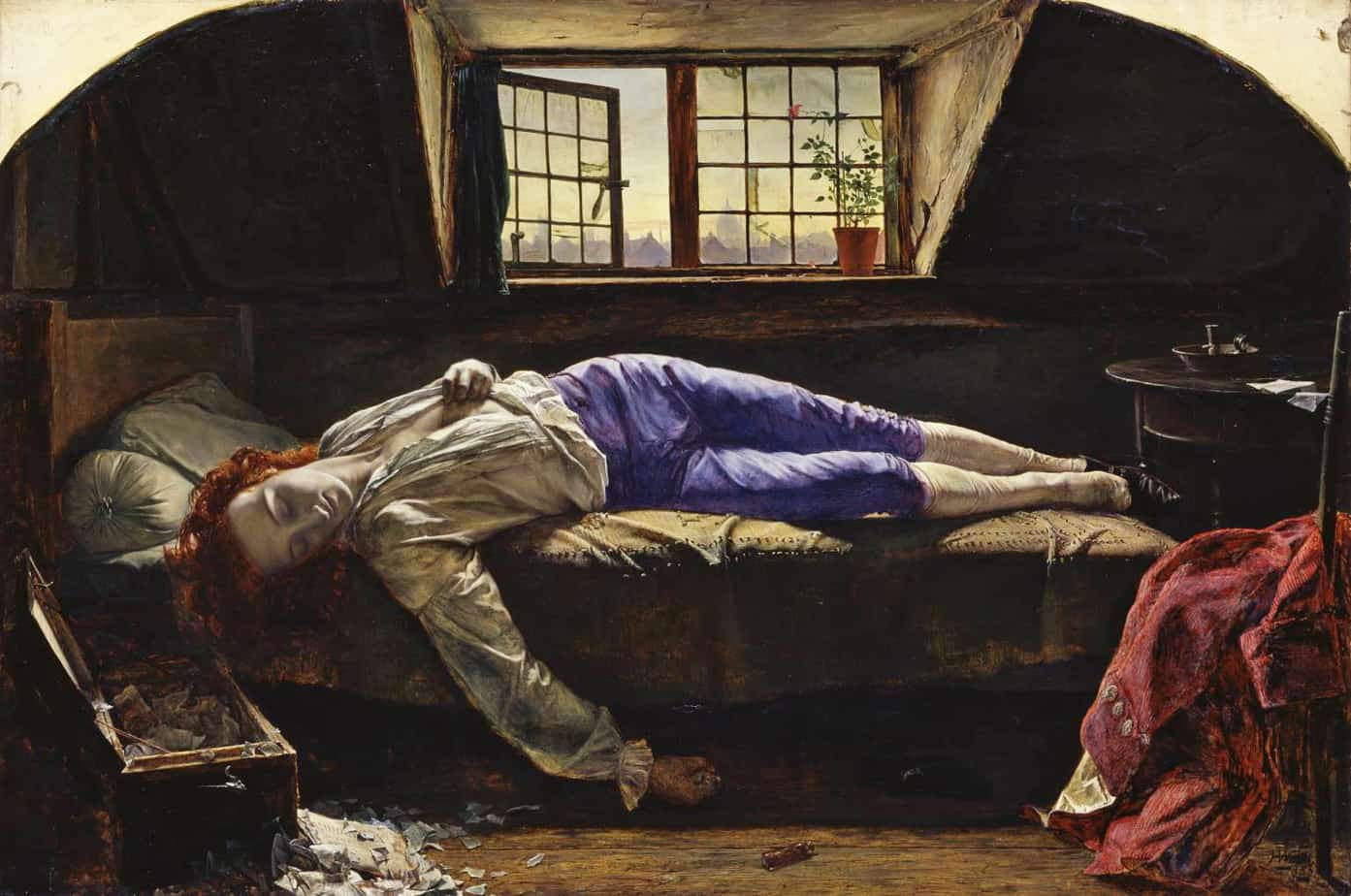
I do worry about what now happens to John Brown. Is the cat hanging around because John Brown is also very old?
RESONANCE
John Brown and the Midnight Cat is an Australian picture book classic, commemorated on a postage stamp.
FURTHER
Toy Story 3 is another story with one happy ending for children (Yay! The toys have found a new owner!) and a sad one for adults (No! Andy’s childhood is over!)
Audiences enjoy stories about kindness, especially when kindness extends to animals, and is reciprocated by animals.
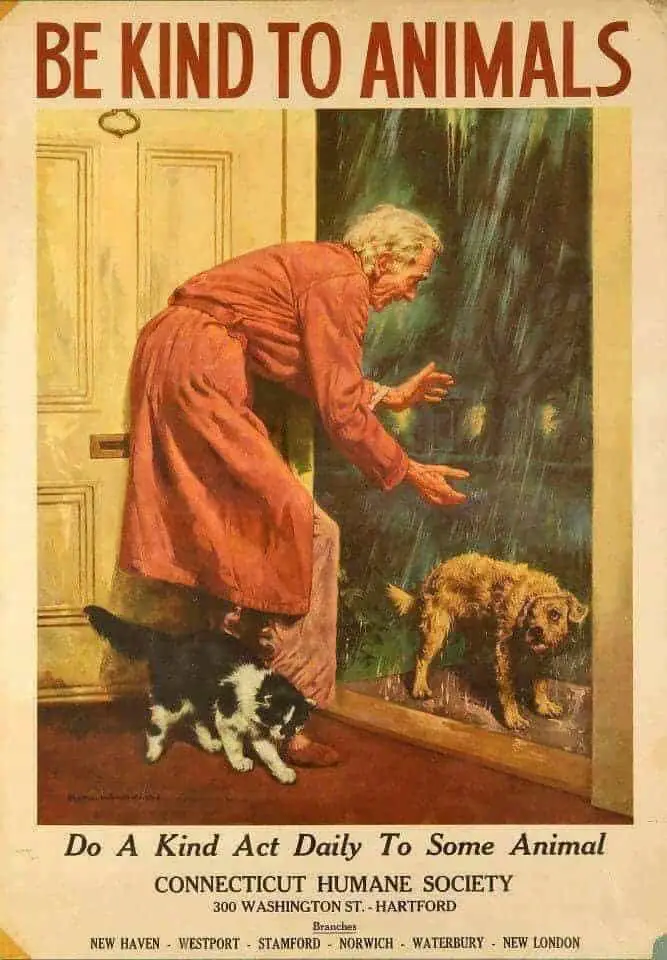
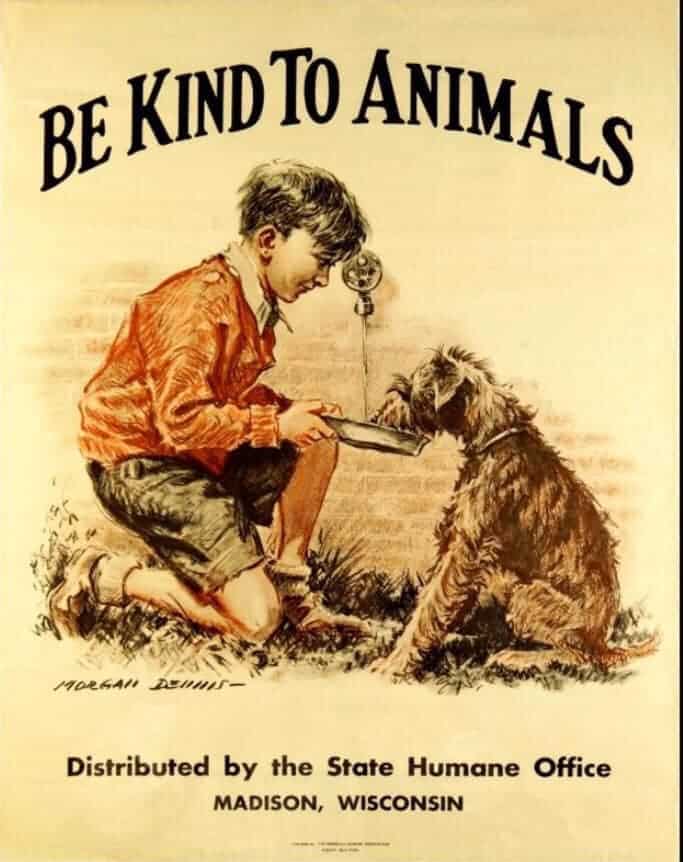
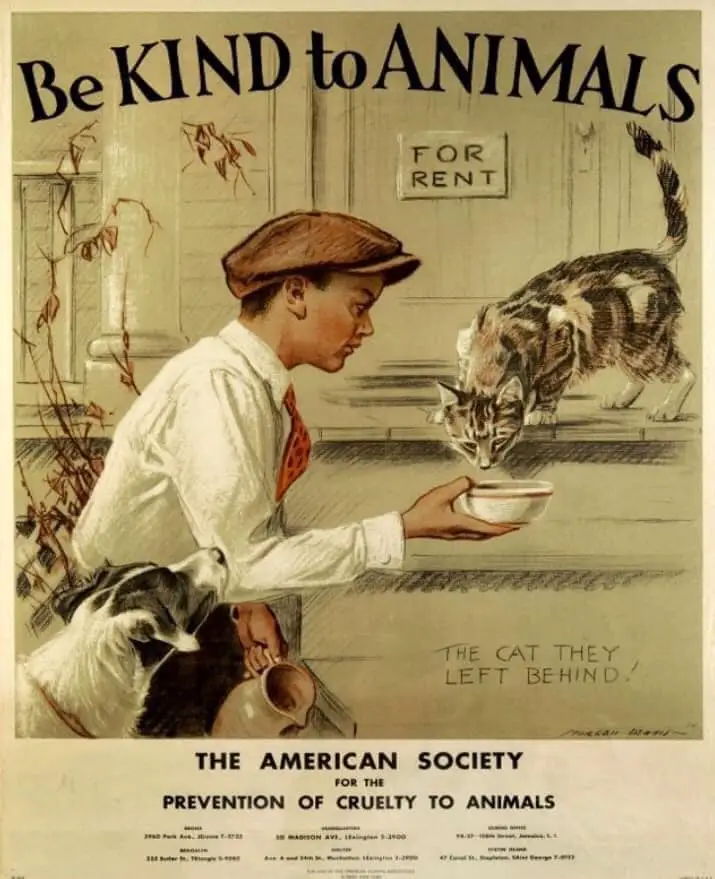
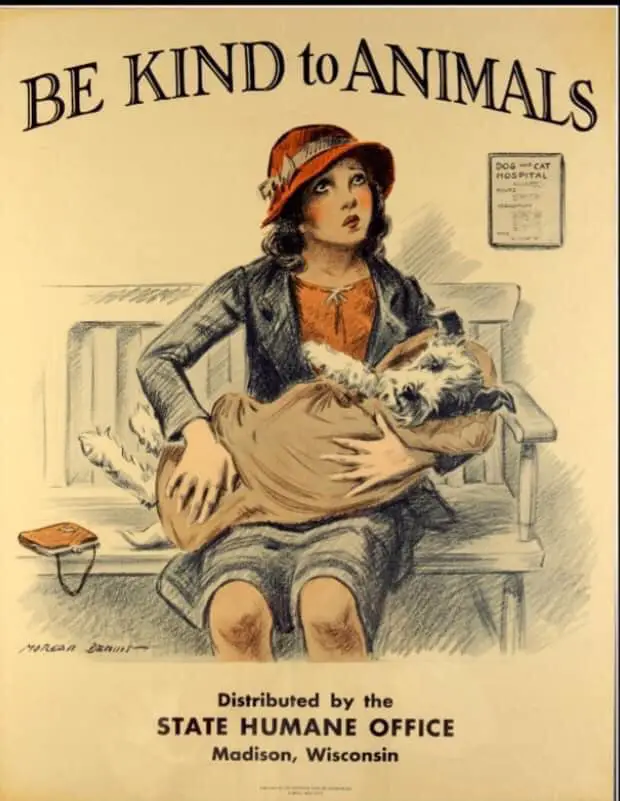
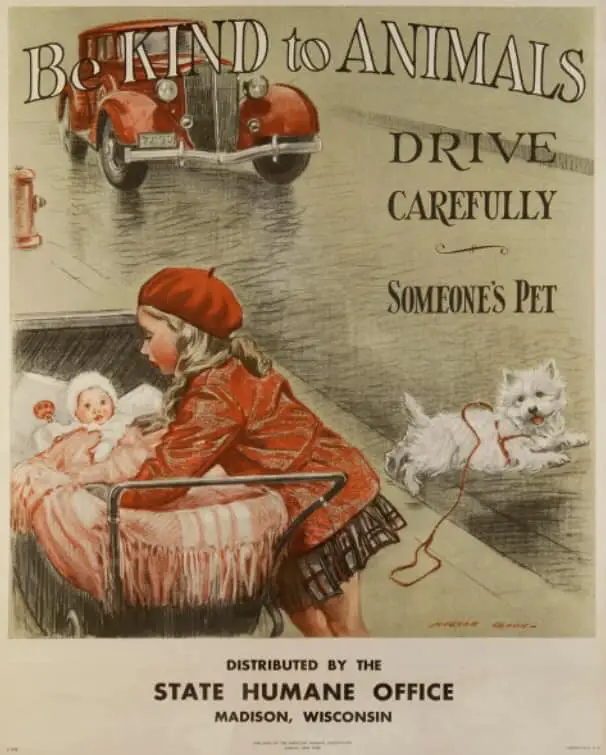
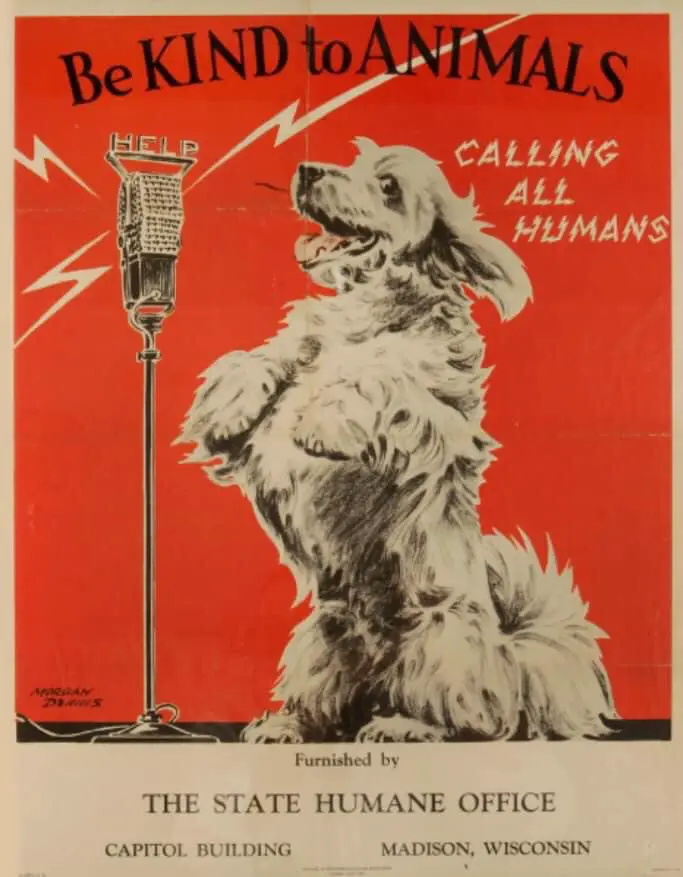
The header painting is an Akseli Gallen Kallela llustration for Kalevala Lemminkäinens Mother (1897).
